Stephaniecarter
On this page, you find all documents, package deals, and flashcards offered by seller STEPHANIECARTER.
- 40
- 0
- 0
Community
- Followers
- Following
40 items
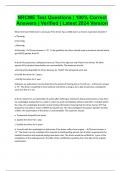
NRCME Test Questions | 100% Correct Answers | Verified | Latest 2024 Version
What minimum PaO2 level is necessary if the driver has an ABG due to a chronic respiratory disorder? a.70mmHg b.55mmHg c.60mmHg d.65mmHg - Correct answer is "D". To be qualified, the driver should meet a minimum arterial blood gas (PaO2) greater than 65. A driver first perceives a whispered voice at 5 feet in his right ear and 4 feet in his left ear. All other aspects of his physical examination are unremarkable. The examiner should: a.Permanently disqualify the driver because he "fai...
- Exam (elaborations)
- • 71 pages •
What minimum PaO2 level is necessary if the driver has an ABG due to a chronic respiratory disorder? a.70mmHg b.55mmHg c.60mmHg d.65mmHg - Correct answer is "D". To be qualified, the driver should meet a minimum arterial blood gas (PaO2) greater than 65. A driver first perceives a whispered voice at 5 feet in his right ear and 4 feet in his left ear. All other aspects of his physical examination are unremarkable. The examiner should: a.Permanently disqualify the driver because he "fai...
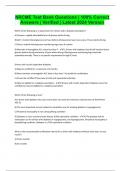
NRCME Test Bank Questions | 100% Correct Answers | Verified | Latest 2024 Version
Which of the following is a requirement for drivers with a diabetes exemption? A) Possess a rapidly absorbable form of glucose while driving B) Self—monitor blood glucose one hour before driving and at least once every 2 hours while driving C) Plan to submit blood glucose monitoring logs every 6 months D) Maintain a Hemoglobin A1C value less than 7 - A. Drivers with diabetes should self monitor blood glucose before driving and every 4 hours while driving. Blood glucose monitoring logs sho...
- Exam (elaborations)
- • 50 pages •
Which of the following is a requirement for drivers with a diabetes exemption? A) Possess a rapidly absorbable form of glucose while driving B) Self—monitor blood glucose one hour before driving and at least once every 2 hours while driving C) Plan to submit blood glucose monitoring logs every 6 months D) Maintain a Hemoglobin A1C value less than 7 - A. Drivers with diabetes should self monitor blood glucose before driving and every 4 hours while driving. Blood glucose monitoring logs sho...
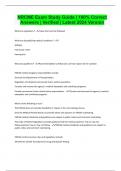
NRCME Exam Study Guide | 100% Correct Answers | Verified | Latest 2024 Version
What are regulations? - Laws that must be followed What are disqualifying medical conditions? - Epilepsy monocular vision hearing loss What are guidelines? - Recommendation to follow but can have raptor ale for variation FMCSA medical program responsibilities include: Oversee the Department of Transportation. Regulation of intrastate commercial motor vehicle operations. Conduct and oversee the agency's medical exemption and certificate programs. Provide commercial motor vehicle drive...
- Exam (elaborations)
- • 24 pages •
What are regulations? - Laws that must be followed What are disqualifying medical conditions? - Epilepsy monocular vision hearing loss What are guidelines? - Recommendation to follow but can have raptor ale for variation FMCSA medical program responsibilities include: Oversee the Department of Transportation. Regulation of intrastate commercial motor vehicle operations. Conduct and oversee the agency's medical exemption and certificate programs. Provide commercial motor vehicle drive...
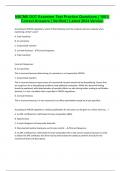
NRCME DOT Examiner Test Practice Questions | 100% Correct Answers | Verified | Latest 2024 Version
According to FMCSA regulations, which of the following must the medical examiner evaluate when examining a driver's eyes? A. Pupil reactivity B. Iris symmetry C. Conjunctival injection D. Corneal thickness - Correct Response: A. Pupil reactivity Incorrect Responses: B. Iris symmetry This is incorrect because determining iris symmetry is not required by FMCSA. C. Conjunctival injection This is incorrect because most causes of conjunctival injection would not be disqualifying. Causes t...
- Exam (elaborations)
- • 12 pages •
According to FMCSA regulations, which of the following must the medical examiner evaluate when examining a driver's eyes? A. Pupil reactivity B. Iris symmetry C. Conjunctival injection D. Corneal thickness - Correct Response: A. Pupil reactivity Incorrect Responses: B. Iris symmetry This is incorrect because determining iris symmetry is not required by FMCSA. C. Conjunctival injection This is incorrect because most causes of conjunctival injection would not be disqualifying. Causes t...
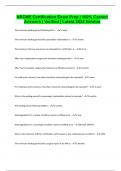
NRCME Certification Exam Prep | 100% Correct Answers | Verified | Latest 2024 Version
The minimum waiting period following PCI is: - 1 week The minimum waiting period after pacemaker implantation is: - 1 month The maximum thoracic aneurysm size allowable for certification is: - 3.5 cm After heart replacement surgery the minimum waiting period is: - 1 year After heart transplant surgery the maximum certification period is: - 6 months For mild aortic stenosis, how often should an echocardiogram be repeated? - 5 years For moderate aortic stenosis, how often should an echocardi...
- Exam (elaborations)
- • 9 pages •
The minimum waiting period following PCI is: - 1 week The minimum waiting period after pacemaker implantation is: - 1 month The maximum thoracic aneurysm size allowable for certification is: - 3.5 cm After heart replacement surgery the minimum waiting period is: - 1 year After heart transplant surgery the maximum certification period is: - 6 months For mild aortic stenosis, how often should an echocardiogram be repeated? - 5 years For moderate aortic stenosis, how often should an echocardi...
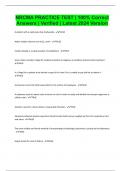
NRCMA PRACTICE TEST | 100% Correct Answers | Verified | Latest 2024 Version
A patient with a rapid pulse has bradycardia - FALSE Water-soluble vitamins are A,D,E, and K - FALSE Carbon dioxide is a waste product of metabolism - TRUE Some states consider it legal for medical assistants to diagnose a condition and prescribe treatment - FALSE It is illegal for a patient to be denied a copy of his chart if he is unable to pay the fee to obtain it - TRUE A physician cannot be held responsible for the actions of employees - FALSE A substance used to impart color to tis...
- Exam (elaborations)
- • 16 pages •
A patient with a rapid pulse has bradycardia - FALSE Water-soluble vitamins are A,D,E, and K - FALSE Carbon dioxide is a waste product of metabolism - TRUE Some states consider it legal for medical assistants to diagnose a condition and prescribe treatment - FALSE It is illegal for a patient to be denied a copy of his chart if he is unable to pay the fee to obtain it - TRUE A physician cannot be held responsible for the actions of employees - FALSE A substance used to impart color to tis...
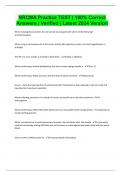
NRCMA Practice TEST | 100% Correct Answers | Verified | Latest 2024 Version
When drawing blood alcohol, the site cannot be prepared with which of the following? - Chlorhexidine When using a microscope with a 10x ocular and the 40x objective in place, the total magnification is - 400X The PH of a urine sample is checked to determine - Acidity or alkalinity When performing a routine phlebotomy, the most common gauge needle is - 20 or 21 When performing a finger puncture, the first drop of blood should be - Wiped away Serum - Is the liquid portion of whole blood aft...
- Exam (elaborations)
- • 17 pages •
When drawing blood alcohol, the site cannot be prepared with which of the following? - Chlorhexidine When using a microscope with a 10x ocular and the 40x objective in place, the total magnification is - 400X The PH of a urine sample is checked to determine - Acidity or alkalinity When performing a routine phlebotomy, the most common gauge needle is - 20 or 21 When performing a finger puncture, the first drop of blood should be - Wiped away Serum - Is the liquid portion of whole blood aft...
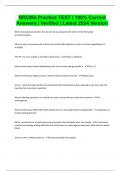
NRCMA Practice TEST | 100% Correct Answers | Verified | Latest 2024 Version
When drawing blood alcohol, the site cannot be prepared with which of the following? - Chlorhexidine When using a microscope with a 10x ocular and the 40x objective in place, the total magnification is - 400X The PH of a urine sample is checked to determine - Acidity or alkalinity When performing a routine phlebotomy, the most common gauge needle is - 20 or 21 When performing a finger puncture, the first drop of blood should be - Wiped away Serum - Is the liquid portion of whole blood aft...
- Exam (elaborations)
- • 17 pages •
When drawing blood alcohol, the site cannot be prepared with which of the following? - Chlorhexidine When using a microscope with a 10x ocular and the 40x objective in place, the total magnification is - 400X The PH of a urine sample is checked to determine - Acidity or alkalinity When performing a routine phlebotomy, the most common gauge needle is - 20 or 21 When performing a finger puncture, the first drop of blood should be - Wiped away Serum - Is the liquid portion of whole blood aft...
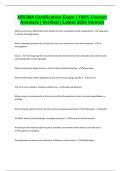
NRCMA Certification Exam | 100% Correct Answers | Verified | Latest 2024 Version
When performing a differential white blood cell count a basophils will be recognized by - Large blue to purple staining granules When collecting specimens for a blood cell count, you would use a tube that contained - An anticoagulant Serum - Is the liquid portion of whole blood after the blood has been allowed to dot and the solid and liquid portions have separated When performing a finger puncture, the first drop of blood should be - Wiped away When performing a routine phlebotomy, the m...
- Exam (elaborations)
- • 14 pages •
When performing a differential white blood cell count a basophils will be recognized by - Large blue to purple staining granules When collecting specimens for a blood cell count, you would use a tube that contained - An anticoagulant Serum - Is the liquid portion of whole blood after the blood has been allowed to dot and the solid and liquid portions have separated When performing a finger puncture, the first drop of blood should be - Wiped away When performing a routine phlebotomy, the m...
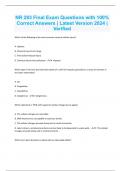
NR 283 Final Exam Questions with 100% Correct Answers | Latest Version 2024 | Verified
Which of the following is the most common cause of cellular injury? A. Hypoxia B. Chemical injury from drugs C. Free radical-induced injury D. Chemical injury from pollutants - A. Hypoxia Which type of necrosis best describes death of a cell from hypoxia, generally as a result of ischemia in the lower extremities? A. Fat B. Coagulative C. Liquefactive D. Gangrenous - D. Gangrenous Which statement is TRUE with regard to cellular change due to aging? A. The cellular changes are reversi...
- Exam (elaborations)
- • 18 pages •
Which of the following is the most common cause of cellular injury? A. Hypoxia B. Chemical injury from drugs C. Free radical-induced injury D. Chemical injury from pollutants - A. Hypoxia Which type of necrosis best describes death of a cell from hypoxia, generally as a result of ischemia in the lower extremities? A. Fat B. Coagulative C. Liquefactive D. Gangrenous - D. Gangrenous Which statement is TRUE with regard to cellular change due to aging? A. The cellular changes are reversi...
